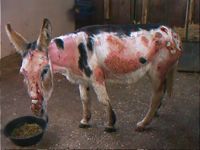Photosensitisation - Donkey
Introduction

Donkeys are liable to the full range of toxic skin disease and perhaps the most alarming is photosensitization arising as a result of chronic/terminal liver failure. Most are due to hepatotoxic plants (and some dangerous chemical poisons with severe destructive hepatic effects). For example, ragwort (Senecio jacobaea) is highly toxic to donkeys.
Clinical Signs
Advanced liver failure signs may be present to guide the clinician, but sometimes photosensitization is the first sign. Extensive, exudative, inflammatory dermatitis arises over exposed areas of the skin. Interestingly, in the donkey, it is D. Knottenbelt's experience that the eruptions are not necessarily always confined to the white skinned areas, although the white areas are invariably much worse.
Aetiology
Direct (primary) photosensitization from primary photodynamic plant ingestion (e.g. Hypericum perforatum, St John’s Wort) does not seem to occur as commonly in donkeys as in horses.
Identifying the underlying aetiology is critical. The investigation of any donkey with dermatitis restricted to the non-pigmented skin MUST include investigation of liver function. There is little point in managing the dermatitis alone in cases with a failed liver unless the underlying condition can be dealt with satisfactorily.
Treatment
No matter what the cause, clearly the first measures are to prevent further damage by removing the donkey from sunshine. Soothing antibiotic creams and lotions can help and many cases will improve significantly with this alone. Alterations in diet may be required and avoidance of primary photosensitizing plants is important. It sometimes takes several weeks before the risks of further exposure/actinic damage have cleared.
Literature Search
Use these links to find recent scientific publications via CAB Abstracts (log in required unless accessing from a subscribing organisation).
Photosensitisation in donkeys related publications
References
- Knottenbelt, D. (2008) Skin disorders In Svendsen, E.D., Duncan, J. and Hadrill, D. (2008) The Professional Handbook of the Donkey, 4th edition, Whittet Books, Chapter 8
|
|
This section was sponsored and content provided by THE DONKEY SANCTUARY |
|---|
